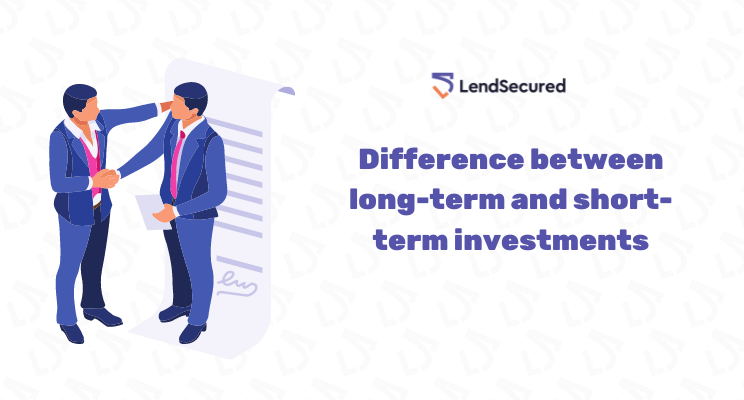The first step in deciding on which investment type is the right for you is differentiating between investment types. Today, we’ll talk about the characteristics and benefits of long-term and short-term investments.
What Are Long-Term Investments
Long-term investments are non-current assets that aren’t typically utilized in a company’s operating activities to acquire revenue. However, there’s no universal definition of “long-term” in the case of investments. A buy-and-hold investor would likely define this term differently than a day trader. For some, a year-long investment is already considered long-term, for others, any investment for a period less than five years is short-term. Long-term investments may include stocks, bonds, real estate, or valuable papers.
Long-term investments can be made by companies or individuals. In the case of a company, whether an investment is considered long-term or short-term depends merely on its placement on the balance sheet. Long-term investments appear on the balance sheet’s asset side.
Long-term investments can be held for dozens of years until they’re sold. Such investments present a high degree of risk though can potentially bring great rewards. For instance, some long-term investments are marked as “held for maturity.” That’s when company A invests in company B and waits until the company grows. An example of such investment is a purchase of PayPal shares by eBay in 2002. But this investment has helped both companies – PayPal to evolve and become independent in 2015, and eBay to gain millions in revenue.
Some long-term investments, however, are made with an intent to sell within a few years span. These are classified as “available for sale” or “trade investments”. There’s a transparent line between short-term and long-term trading investments that is only determined by the holding period.
Some long-term investments are used in a company’s operating activities but are held as investments on paper. An example of such investment is land that can be sold to gain revenue.
Long-term investments are almost always non-liquid. Non-liquid assets can’t be liquidated quickly and may lose value after the sale. Their prices are often highly volatile. This means they fluctuate significantly depending on the market state. A volatile market is defined by the degree of price variation, not the price level.
What Are Short-Term Investments
Short-term investments are also called temporary investments or marketable securities. These are investments that are converted into cash over a short time span. Just like with long-term investments, there’s no universally defined time frame. For some investors, short-term refers to a month, for others five years. When a company makes short-term investments, they appear in the current assets section, and they’re typically expected to last under one accounting year.
To be classified as short-term, an investment must be liquid. Liquid assets are ones that can be easily converted into money and thus are perceived as the equivalent of cash. An example of such assets are bonds, stocks, and mutual funds. These can be sold much faster than non-liquid assets such as land or vehicles and don’t lose value in the sale.
Short-term investments include crowdlending, also called peer-to-peer lending. In this method, investors co-fund projects for a pre-defined interest rate. The funds must be returned within a specified time frame. Legitimate crowdlending platforms assess the risks, suitable interest rate, and the borrower’s credit score before publishing any project.
The Benefits or Short-Term Investments
Now that you know the difference between the two investment types, you may be wondering is short-term investing worth it. Such investments present numerous benefits to companies and individual investors. The core advantages of temporary investments are flexibility and a lower degree of risk.
The sums involved in short-term investments are typically much lower than those involved in long-term investments. Mot short-term investors use diversification strategy to minimize risks while maximizing profits. This strategy is based on investing smaller sums into several projects rather than putting all odds on a single project. If one of the projects doesn’t succeed, the investor doesn’t lose all their money. Plus, diversification helps non-sophisticated investors to build a diverse portfolio.
Short-term investments are a great way to learn investments in practice. Some long-term investments may not be available for beginners due to government legislation or partnering company policies. Temporary investments, on the other hand, are easy to get started with and don’t require extensive education or experience. However, it’s crucial to follow a pre-defined short-term investment strategy and choose projects wisely.
As the funds aren’t tied up for an extended period, the investor can reinvest in another project shortly afterward. Reinvesting acquired profits helps to accumulate even more revenue over time rather than spend it.
Long-term investments also present a higher risk due to the inability to accurately predict their potential and price volatility. There’s very little control over the constantly changing market over several years or decades. With short-term assets, investors can judge the project potential right away, investing only in the most profitable options. The market doesn’t usually change rapidly within a year’s time, so investors know what to expect.
Finally, short-term investments offer potentially high returns considering how low the risks are. Some short-term investors earn sums comparable to those obtained from selling long-term assets in a much shorter time span. That’s because short-term investments also differ in terms of risk and inversely proportional return rate. Lower-risk projects usually bring lower returns, while higher-risk projects can be extremely profitable. Some projects offer over 20% return rate. Long-term investment average return rate, in turn, is about 8%. That’s because while some long-term projects can bring over 40% ROI, many of them fail and result in losses.
Invest Wisely, Get Returns Quickly
Hopefully, our guide has helped you determine which investment type is right for you. Any financial decision should be well-informed and evaluated. Our mission is to minimize risks while maximizing profits in short-term investments. Don’t hesitate to contact LendSecured directly with any questions regarding the platform and crowdfunding investments. We strive to share the necessary knowledge and bring peace of mind to all parties of the agreement.
